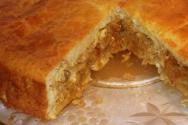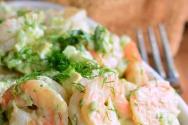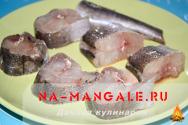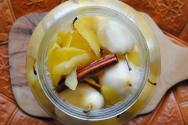Green onions - calories. How many calories are in onions (green and onions) Green onions calories per 100 grams
Chives are a popular green that begins to grow in the spring, although the healthy plumes can be grown throughout the year if desired. Spicy taste helps to diversify different dishes, so, it is put in salads and snacks, and also complements fish and meat. Due to its rich composition, greens are used in folk medicine and cosmetology. As for the information about how many calories are in green onions, and whether it is possible to eat them while losing weight, we will figure it out.
Benefits of green onions
Interestingly, onion feathers contain more substances beneficial to the body compared to onions. It is thanks to green onions that you can replenish the vitamin supply lost during the winter. It is actively fighting against spring vitamin deficiency, which is abundant in green feathers. Healing properties greens help in the treatment of respiratory diseases. It has been noticed that the body of people who regularly consume green onions, better resists the negative effects of viruses and infections. The product contains chlorophyll, which takes part in hematopoiesis processes, so it is useful for anemia.
Greens have the ability to improve digestion, which helps other foods be better digested and absorbed in the body. Onions also improve metabolism. The calorie content of green onions is low and amounts to 19 kcal per 100 g. As for the nutritional value, there are no fats in such onions, proteins are 1.3 g, and carbohydrates are 4.6 g. In addition, green feathers act on the body as a diuretic that helps get rid of excess fluid, and this is the main cause of swelling and cellulite. Since there are few calories in green onions, you can safely include this product in your daily diet.
Green onion (feather) rich in vitamins and minerals such as: vitamin A - 37%, beta-carotene - 40%, vitamin C - 33.3%, vitamin K - 139.1%, silicon - 16.7%, cobalt - 70%, molybdenum - 28.6%
What are the benefits of green onion (feather)
- Vitamin A responsible for normal development, reproductive function, skin and eye health, and maintaining immunity.
- B-carotene is provitamin A and has antioxidant properties. 6 mcg of beta carotene is equivalent to 1 mcg of vitamin A.
- Vitamin C participates in redox reactions, the functioning of the immune system, and promotes the absorption of iron. Deficiency leads to loose and bleeding gums, nosebleeds due to increased permeability and fragility of blood capillaries.
- Vitamin K regulates blood clotting. A lack of vitamin K leads to an increase in blood clotting time and a decreased level of prothrombin in the blood.
- Silicon is included as a structural component in glycosaminoglycans and stimulates collagen synthesis.
- Cobalt is part of vitamin B12. Activates enzymes of fatty acid metabolism and folic acid metabolism.
- Molybdenum is a cofactor for many enzymes that ensure the metabolism of sulfur-containing amino acids, purines and pyrimidines.
A complete guide to the most healthy products you can look in the app
Chives are a very popular green that provides many positive benefits for our health.
As soon as the snow melts, the first leaves of the vitamin product appear, but this vegetable is so unpretentious to the conditions that you can easily get feathers even in winter on the windowsill. Well, a very simple option at any time of the year is any hypermarket.
This vegetable has taken root in our kitchen so much that we don’t even think about how many calories are contained in 100 grams of the product.
Calorie content of green onions
But still, this is a rather interesting question for people who monitor their health and lead a healthy lifestyle. What is the calorie content of green onions and how does it differ in composition from other varieties?
100 grams of green onions contain only 19 kcal. So you can safely add it to your daily diet without any danger to your figure. Onions have a rather strong aroma that lingers throughout the food. This scares many people. But knowing what benefits it brings, it will become much easier.
After all, as you know, any variety of onion contains a large amount of phytoncides, which kill all viruses and microbes flying in the air only with their smell. So those who eat onions and “smell” kill millions of viruses and bacteria only with their exhalation.

Any vegetables eaten by people contain a wide range of vitamins, minerals, micro- and macroelements, which are synthesized only by plants. And during heat treatment they are destroyed. So eating fresh vegetables allows you to increase the supply of nutrients to the body.

The nutritional value of onions can also please you - it does not contain fat, carbohydrates 4.5 grams, and proteins 1.3 grams. It contains a lot of water, which, when entering the body, dissolves all toxins at the cellular level, which is 93%. This allows you to remove excess waste water, working as a diuretic.
What are the benefits of green onions?

Who should use onion greens with caution?
Like any product, onions have their own negative properties. It has the ability to increase the acidity of the body as a whole, so it should be used with caution by people with diseases of the gastrointestinal tract, kidneys and liver.
If you have hypertension, you need to pay special attention to the amount of product you consume, as it can cause surges in blood pressure.
There are no special ways to use green onions, since they are mainly used only fresh.

When we add green onions to dishes, we have a specific goal - to enrich the dish with vitamins and give it an aesthetically beautiful appearance.
Onions go great with all vegetables. Salads prepared with fresh green onions have a piquant taste. Do not be afraid of the unpleasant odor from this vegetable if you eat a small amount of seeds or nuts after eating it.
How to choose and store fresh feathers?
Experts believe that stems with a highly saturated green color have a sharper taste, while those with a lighter shade have less pungency. White and dense bulbs indicate good quality. Any stains or bruises spoil the product.
“Calories” is a word that modern women are terrified of, because today it is common to be slim. When looking for waist-friendly foods, they turn to fruits and vegetables. And this is absolutely correct: they will feed you and will not allow you to gain weight. Those losing weight often wonder what the calorie content of green onions is. Let's discuss this issue.
Onions - vitamins all year round!
Green onions are a popular product that does not leave store shelves all year round. However, you don’t have to go to the market to buy it: it’s easy to grow it at home on the windowsill. The green part of the onion is used in folk medicine and cosmetology.
In addition to being rich in vitamins, this vegetable is also an excellent culinary ingredient. The pungent taste of onion feathers helps diversify various dishes, especially salads. But can these greens increase weight? How many calories are in green onions and do they contain fat?
What is the calorie content?hiding in the green onions?

Put your calculator aside, as you won’t have to spend a long time counting calories for different members of this delicious family. It's hard to find a lower-calorie product than green onions. Its calorie content per 100 grams is as follows:
- feather – 19 kcal;
- shallot – 72 kcal;
- leek – 33 kcal;
- batun – 34 kcal.
Thus, in first place in terms of dietary abilities was our good friend - feather green onions. It is important not only how many calories are contained in its stems, but also that it contains absolutely no fat. It contains only proteins (1.3 g) and carbohydrates (4.6 g). Onion roots (turnips) are much higher in calories. Onions contain 41 kcal.
Green onions in dishes are not primarily responsible for their energy value. Becoming an ingredient in salads and other delicacies, it makes a modest contribution, but the total calorie content looks like this:
- onion and sour cream salad – 56 kcal;
- salad from fresh cucumber, onion, boiled egg and sour cream – 96.6 kcal;
- radishes, green onions, sour cream, eggs – 94 kcal;
- cabbage, beets, sour cream, dill, onions – 98 kcal.
To prevent the salad from leading to weight gain, you should use the simplest ingredients in addition to onions: cucumbers, tomatoes and other vegetables. As a dressing, you should not use fatty sour cream, much less mayonnaise. Better to replace these difficult to process foods olive oil. And one more secret: the green onion does not need to be chopped very finely, otherwise its taste will be lost in the salad.
The benefits of green onions for weight loss and health. Is there any harm possible?

Each vegetable has its own positive properties. However, not all garden products help you lose weight. But energy value and the composition of green onions are unique, so they are the best ally in the fight against weight and an indispensable assistant in maintaining health.
The green parts of onions are rich in vitamin C, which protects against colds and strengthens the immune system. They also contain carotene, which promotes weight loss. To have a normal weight and not get sick, it is recommended to consume feathers all year round, regardless of whether you are overweight. The aerial part of the onion is often called the “pump” due to the fact that it produces a good diuretic effect. This property is also useful for those who are dissatisfied with their weight.
What harm can this cute vegetable cause? It has a fairly noticeable pungency - this is what makes it unsafe for those who suffer from disorders of the digestive organs. If you have gastritis or an ulcer, then it is better to refrain from eating the vegetable, as it will irritate the gastric mucosa. Onion can increase blood pressure and cause an attack of bronchial asthma - this too should not be forgotten.
Parsley, dill, cilantro, fennel, basil and other greens are a source of vital microelements and vitamins. It’s easy to sow dill or parsley in the garden, in a box on the balcony or in a flower pot on the windowsill, and you will be sure that there are no unnecessary “chemicals” in the plants. When choosing herbs at the market, it is better to give preference to those grown in your region. It is enough to eat a small bunch (30-50 g) of greens a day, which includes dill, onions and parsley; its calorie content will be only 12-18 units.
Composition and beneficial properties of parsley
All parts of the plant have healing properties: leaves, stems, seeds and roots. Despite low calorie content, parsley is rich in B vitamins (B1, B2, B9, B12), A, C, E, PP, iron, potassium, calcium, selenium, magnesium, zinc and iron. The carotene content is more than in carrots, and ascorbic acid is no less than in citrus fruits. The daily dose of vitamin K is contained in 10 g of fresh herbs.
This useful plant helps improve blood composition, improve intestinal function and strengthen the heart muscle. The juice is used in cosmetology to whiten skin, improve hair growth and fight dandruff.
Seeds and root vegetables contain a lot of useful inulin - a natural prebiotic that stimulates the biochemical processes of digestion. The leaves and roots contain phytoncides, pectins and flavonoids, which have anti-inflammatory, bactericidal and antioxidant effects.
Dill, whose calorie content is slightly lower than the nutritional value of parsley, contains flavonoids and essential oils, carotene and riboflavin, nicotinic and ascorbic acids. Green onions contain a lot of vitamins C, PP and carotene.
Despite all beneficial features and low calorie content, parsley may be contraindicated for people with diseases of the gastrointestinal tract or urinary system. Pregnant women should use parsley juice or root with caution due to its stimulating effect on uterine tone. Two or three sprigs of greenery will replenish the reserves of vitamin E, which is important for the female body during pregnancy.
Calorie content and nutritional value of parsley, dill, onion
The energy value of parsley, dill and green onions is low, therefore the calorie content of these products is one of the lowest.
The calorie content of fresh dill is 38 units; 100 g contains 0.5 mg of fat, 2.5 g of protein and 6.3 g of carbohydrates. Parsley contains 9 kcal more, fat - 0.4 g, protein - 3.7 g, carbohydrates - 7.6 g. 100 g of root vegetables contains 49 kcal, 0.6 g fat, 1.5 g protein and 10, 1 g carbohydrates.
Green onions contain 19 calories, 1.3 g protein, 4.6 g carbohydrates and 0 g fat.
The benefits of greens on a diet
Nutritionists recommend greens in various health programs. Doctors take into account the low glycemic index, how many calories are in dill and parsley, calories and vitamin content when culinary processing or freezing.
Eating greens helps:
- normalization of metabolic processes in the body;
- reducing the level of bad cholesterol;
- removing toxins and excess fluid;
- maintaining normal insulin levels;
- breakdown of fat cells and normalization of digestion;
- improving blood circulation by strengthening capillaries and activating the production of red blood cells.
Parsley is used for weight loss, because it has a diuretic effect, relieves swelling and promotes the removal of salts. Coarse plant fibers cleanse the intestines and have a mild laxative effect. Fiber prolongs the feeling of fullness and helps reduce the amount of food consumed.
A diet for athletes can include up to 500-800 g of greens, but it must be taken into account that parsley reduces sweating. During training, harmful substances are eliminated through sweat. Sweating plays an important role in thermoregulation processes.
By including spinach, celery, parsley root and greens in your diet, the calorie content can be reduced and the vitamin and mineral value can be significantly increased. Essential oils The composition of plants helps calm the nervous system and normalize disturbed sleep, which strengthens the immune system and improves the general condition of the body.
Regular consumption of beneficial herbs stabilizes the functional state of internal organs, normalizes intestinal microflora and slows down the aging process.
Recipes for fresh and frozen greens
Fresh herbs (cilantro, dill, spinach, wild garlic, green onions and garlic) are best suited for salads. Minimum set - green onions, parsley and dill, seasoned vegetable oil(unrefined sunflower, flaxseed, pumpkin or olive) and lemon juice with mustard - a tasty and healthy dish.
You can increase the nutritional value by adding cooked chicken or quail eggs, soft unsalted cheese, pine nuts or sunflower seeds, pumpkin seeds. For dressing, nutritionists recommend using low-fat sour cream, thick yogurt or yogurt. Greens go well with meat and vegetable dishes; Finely chopped parsley and dill are added to soups, borscht, and vegetable smoothies.
Weight loss diets include different variants fat burning smoothies:
- Grind 20 g of celery, parsley and dill in a blender, add cucumber, carrot, 2 tbsp. lemon juice and half a glass of mineral water;
- Grind 50 g of green stalks of celery and parsley, peeled green apple, orange and 200 g of fresh pineapple in a blender;
- Grind 2 fresh peeled cucumbers and 50 g of dill with parsley in a blender.
For breakfast, it is useful to eat low-fat cottage cheese (150-200 g) with finely chopped herbs or egg white omelette(chopped greens without heat treatment add to plate). Dinner can be replaced with a glass of kefir or unsweetened yogurt with chopped herbs.
The calorie content of frozen greens does not change. To preserve vitamins, you should follow simple rules:
- freeze only fresh herbs;
- rinse thoroughly under running water;
- blot with linen or paper towel and dry in the shade;
- It is better to chop with a knife with a ceramic blade;
- put single portions into small bags;
- Do not refreeze greens.
Frozen parsley (dill, cilantro, basil) is added at the end of cooking or stewing. In cocktails and smoothies, frozen greens can replace ice. For cooking, greens should not be thawed first.







